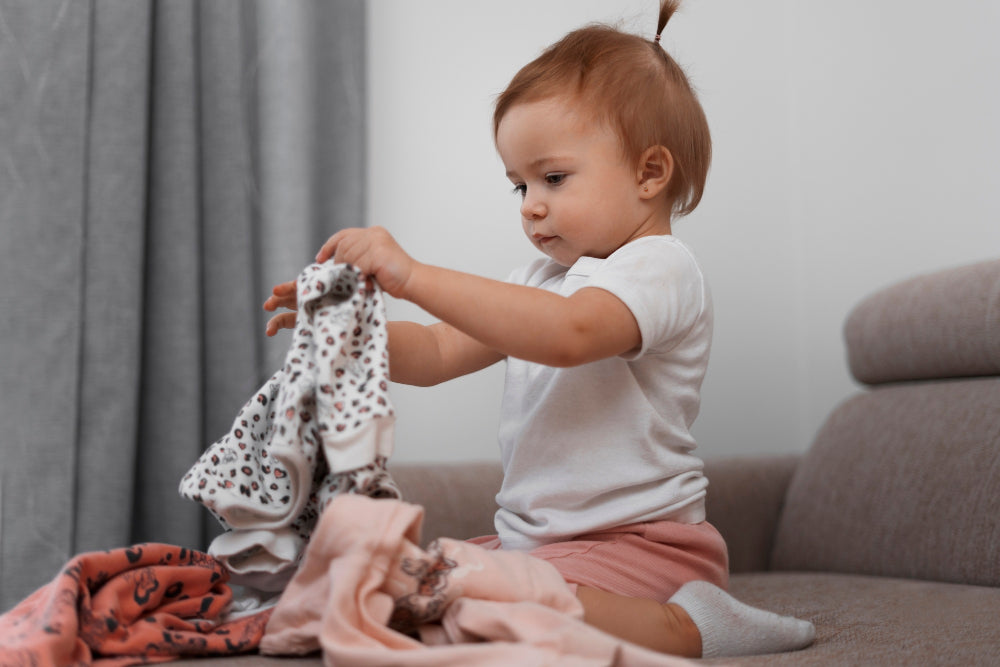Smart homes have changed the way we care for our babies, especially when it comes to sleep. With tools like smart thermostats, baby monitors, and humidity sensors, it is now simple to create a safe and comfortable sleep space.
However, no matter how advanced your home is, knowing how to dress newborn for sleep is very crucial.
In this guide, you will learn about the best sleepwear options, fabric choices, and tips on dressing newborn for sleep especially in smart homes.
What Should a Newborn Wear to Sleep in Smart Homes
When selecting a dress for your baby to sleep in, you need to keep in mind their comfort and safety first. Here are some of the most popular options that can work well for a newborn’s sleep:
Baby Gowns
Baby gowns are a practical choice for newborns, especially in the early weeks. Their open-bottom design helps you change a late-night diaper easily, even in smart dimmable lighting, without fully waking your baby.
Baby gowns also provide your baby with the right amount of breathability because of their loose fit. Plus, you can easily add or remove layers depending on real-time temperature readings from your smart baby monitor.
Footed Sleepers
Footed sleepers are a cozy and all-in-one option that keeps your baby warm from head to toe. They come up with snap closures or zippers, and you don't need extra socks or blankets.
They provide the right level of warmth when your smart thermostat keeps the home at a cooler but consistent temperature, usually around 68–72°F (20–22°C), which is ideal for baby sleep.
Onesie
Onesies are a must-have in every newborn’s wardrobe, and they’re super helpful in smart homes too. They make dressing quicker and ensure baby monitors track comfort more accurately.
In warmer rooms, a short-sleeved cotton onesie might be all your baby needs. On cooler nights, you can layer it under a sleep sack or footed sleeper.
Their snug fit keeps the baby comfortable and avoids loose fabric in the crib, which can increase the risk of suffocation or Sudden Infant Death Syndrome (SIDS).
Swaddle
Swaddling is the practice of gently wrapping your baby in a soft blanket or cloth to create a secure feeling similar to being in the womb.
This helps newborns feel safe and can lead to better sleep. However, in smart homes with regulated temperatures, you should choose lightweight and breathable swaddles to prevent overheating.
Sleep Sack
Sleep sacks have become the safest alternative to loose blankets in cribs. They act as wearable blankets. They provide warmth while eliminating suffocation hazards and helping reduce the risk of SIDS.
Sleep sacks come in various thicknesses so that you can choose a lighter one for warmer nights and a thicker one for colder nights.
Other Accessories to Consider for Perfect Sleep
In addition to core sleepwear, these accessories can help keep your baby comfortable and safe during sleep:
- Mittens to prevent face scratching during sleep
- Socks to keep feet warm if not covered by sleepwear
- Lightweight hats only if your baby’s head feels extra cold
Top Fabrics That Help Your Baby Sleep Better

The fabric you choose also plays a bigger role, as it directly impacts your baby’s comfort, safety, and quality of sleep.
Below, we have mentioned some of the comfortable fabrics you can choose from:
Muslin
Muslin is a lightweight and loosely woven cotton fabric prized for its breathability. It keeps air circulating and reduces heat buildup.
Muslin sleepwear is perfect for warmer nights in smart homes to keep your baby cool in sleep.
Jersey
Jersey knit fabric is soft and stretchy and hugs your baby’s body gently. It provides warmth while remaining breathable and is a great choice for moderate temperatures.
Fleece
Fleece offers excellent insulation and is ideal for colder nights. It retains heat effectively but can be less breathable. You can use it when your smart thermostat indicates cooler room temperatures to keep your baby warm without extra blankets.
Cotton
Cotton is soft, highly breathable, and one of the best fabrics for your baby’s sleepwear. Its gentle texture prevents irritation on your baby’s sensitive skin and lets your baby sleep comfortably throughout the night.
How to Dress Infant for Sleep Based on Room Temperature

When deciding on sleepwear for your baby, always remember the general rule of layering. According to this rule, you need to dress your baby in one extra layer than you would wear comfortably in the same environment. This approach ensures your infant stays warm without overheating.
Here's a practical guide to decide what should baby wear to sleep based on room temperature:
|
Room Temperature (°F) |
Recommended Sleepwear |
|
Below 65°F |
Long-sleeved onesie + sleep sack or fleece sleeper |
|
65°F – 70°F |
Long-sleeved onesie + sleep sack or cotton sleeper |
|
70°F – 75°F |
Short-sleeved onesie or baby gown + light sleep sack |
|
Above 75°F |
Lightweight onesie or just a diaper + muslin swaddle |
Conclusion
By now you have learned ‘what should a newborn wear to bed’ and how to dress a newborn.
Understanding the discussed dressing options and fabrics along with how to layer based on room temperature, can help you create the optimal sleep environment.
We also suggest always choosing your baby’s clothes from trusted brands like Magickal Wear to ensure comfort and quality care for your little one.
FAQs
What sleepwear should I avoid when dressing my newborn for sleep?
Avoid clothing with loose buttons, strings, and non-breathable fabrics like polyester that trap heat. Choose well-fitted and simple designs for safer and more comfortable sleep.
Can a baby sleep with a blanket?
It is generally not safe for babies under 12 months to sleep with loose blankets. Blankets can increase the risk of overheating and Sudden Infant Death Syndrome (SIDS) due to suffocation. Instead, use safer options like sleep sacks or wearable blankets that provide warmth without loose fabric.
What are the signs that my baby’s sleepwear is too warm or too cold?
If your baby is sweating or flushed, the sleepwear might be too warm. Conversely, if they have cold hands and feet and seem fussy, they might be too cold. You need to adjust layers accordingly.


